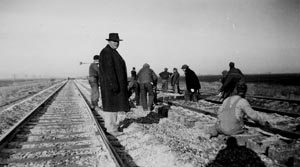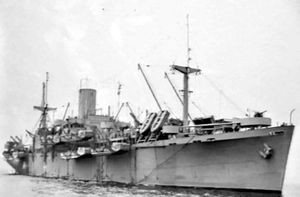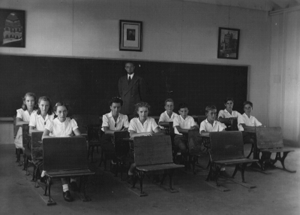REAL PEOPLE
The Human Cost of Civil Liberties Violations

Crystal City, TX Internment Camp
During World War II, America had to act decisively to protect itself from dangerous individuals in its midst. To achieve this legitimate goal, our government ignored civil liberties to an unacceptable degree and trampled far too many innocent lives. The human cost was unconscionable. Rather than protecting potential American-born and foreign-born victims of mounting hysteria, our government used these security concerns to justify oppression. Ethnic Germans, Japanese and Italians suffered greatly for their “enemy” ethnicity.
Selected personal stories are briefly summarized below. The experiences of these individuals clearly show that personal freedoms must be protected most when they are most under assault. The stories were selected because they illustrate the typical forms of wartime mistreatment by the US government: raids, ransacking of homes, selective internment, exchanges, repatriation and exclusion. In each case, the reader should assess the extreme consequences resulting from abrupt governmental action driven by hysteria.
Exchange Families
The Eiserlohs
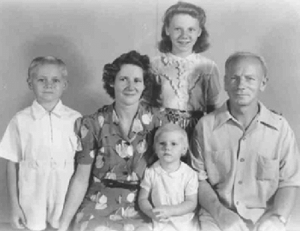
The Eiserloh family in Crystal City, Texas Internment Camp
The Eiserlohs, a family of five (including three American-born children, ages 11, 6 and 11 months) lived in rural Ohio in a home built by Mr. Eiserloh, a German-born engineer. In December 1941, the FBI took Mr. Eiserloh away. The family didn’t know where he was for weeks.
Mrs. Eiserloh tried to survive alone, shunned by her previously friendly community, but finally had to sell their house far below its value. The government immediately froze the proceeds, severely restricting their meager funds. The young family had to live in the basement of a relative’s home for 2 years until finally they were reunited with Mr. Eiserloh in the Crystal City family internment camp in Texas.
After several inquiries by the government, in desperation, Mr. Eiserloh reluctantly agreed to repatriation. The family, all slated for exchange for Americans held in Germany, was loaded onto a train in late December with many other internees bound for New York.
The SS Gripsholm waited there for its 1000-person cargo, scheduled for a January 1945 departure. This was one of six exchange voyages negotiated between Germany and the US. The government got a bonus. Mrs. Eiserloh gave birth to a boy on the train.
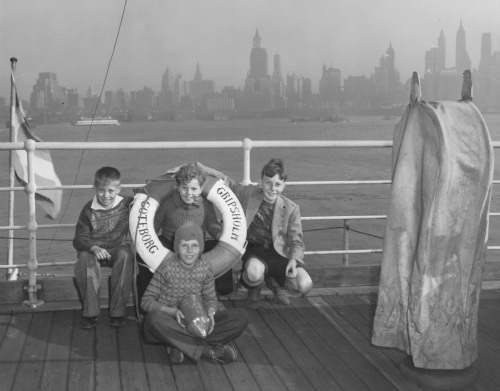
German American children internees leaving New York City for Germany.
The Eiserlohs, now six members, crossed the Atlantic during the height of the war. They landed in Marseilles and traveled eventually to Bregenz in boxcars where they were exchanged for Americans, primarily civilians. Virtually all their meager belongings were stolen. The Eiserlohs walked into a world of turmoil and Allied bombs. No one welcomed them back. Their family in Germany, mystified by their return and struggling to survive, hardly expected or wanted them.
In the dead of one of the coldest, snowiest winters on record, the young family traveled north toward Frankfurt with their few remaining belongings, constantly in fear of Allied attacks, sometimes walking, sometimes on a train, any way they could. They abandoned one train quickly while being strafed by American planes.
In late February, after two months of difficult travel from Texas, they were forced to live in a relative’s cramped basement again. The children, Americans, barely spoke German. The family was viewed with hostility and ridiculed, not unlike their American experience. Understandably enough, the Gestapo suspected Mr. Eiserloh of being an American spy for the advancing US Army. He was questioned, beaten severely by six SS men in front of the young family and dragged away.
Mrs. Eiserloh, alone again and bordering on a nervous breakdown, despaired of her husband’s survival. Her mental health was never the same again. Several months later, advancing US Army troops freed those imprisoned in the camps. Mr. Eiserloh returned home and the family managed to survive in the difficult years following the war.
Years later, the two oldest children, now teenagers, left their parents to return to the US. Perhaps coincidentally, after brother Lothar received a US Air Force security clearance, his parents and two younger siblings were allowed to return to the US. The baby boy born on the train was killed in a car accident shortly thereafter. Mr. Eiserloh could never find a good job again in Germany or the US.
A broken man, he died at age 65 in a supermarket aisle. At 59, his wife was alone again. The deep scars of the experience still color the lives of the remaining Eiserloh children. To this day, the family does not know exactly why Mr. Eiserloh was interned, but they think it was because of his membership in a German musical society.
The Grabers
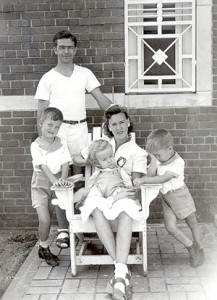
Graber Family in Seagoville, Texas 1943
Werner Paul, Theo, Teddy, Emmy and Gunther
The Grabers, two young boys and their German-born parents, lived in New Jersey in an apartment building owned by a Polish landlord. When Hitler invaded Poland, the relationship became strained, so the Grabers moved. The landlord contacted the FBI. Mr. Graber worked on “war sensitive technology” for the International Nickel Company. The FBI began to watch their home. In September 1942, they took him for several hours of questioning. In November, they ransacked the house.
Mrs. Graber, several months pregnant, fainted and fell down the stairs. Shortly thereafter, Teddy was born, premature and handicapped, and had to remain hospitalized. The family was advised that they would be interned after Christmas. Mr. Graber wrote to President Roosevelt pleading for mercy. The agents came without notice in mid-January. The family threw together their belongings and picked up Teddy at the hospital.
The family was interned with hundreds of others at Ellis Island until they were shipped to Seagoville, Texas, several months later. One and one-half years later they were sent to Crystal City.
In despair, after being pressured to repatriate, the Grabers agreed to return to Germany. With the Eiserlohs and many others, they were shipped to New York and set forth on their hazardous journey. In the camps and on the SS Gripsholm, they met many Latin Americans, also to be exchanged. At least one German Jewish man was also sent back. Exchanged and dumped in Germany, they made their way through the ravaged terrain to Mr. Graber’s family. Unable to find work, Mr. Graber and the eldest child, age 5, hitchhiked some distance to Mrs. Graber’s hometown.
Along the way, French agents stopped them, tore up Mr. Graber’s American ID and spat in his face. Only young Werner’s American citizenship saved them. Mr. Graber and Werner lived in a wooden barrack temporarily, refugees from the West. Mr. Graber’s application for assistance was denied. How could an impoverished German refugee from America exist? In mid-April Mrs. Graber’s parents’ home where the family was living was destroyed in a tank attack.
The post-war years were extremely difficult. Food and medication were scarce. Teddy died in 1948 of pneumonia. Mr. Graber took over his father’s tooling business because a US Army truck accidentally killed his father while he was getting milk from a local farmer for the grandchildren.
The boys exercised their birthright and returned to the US in the late 50s. Mr. and Mrs. Graber never returned. Mr. Graber always tried to justify the decision to repatriate to himself. Was it the right thing to do? Did he deprive his children of a normal life? Should he have stayed in the camps and returned to New Jersey again? Who knew how long they would be imprisoned? Would life have been easier had he stayed in the US? Mr. Graber’s lifelong bitterness and self-doubt are another cruel legacy of internment. The Grabers have tried to learn why they had to endure such an experience. What had their landlord said? Was it Mr. Graber’s job?
A Jewish Internee
Eddie Friedman was born of Jewish parents in Hamburg in 1892. Doctor Friedman, as attorneys are known in Germany, practiced law until forbidden to do so by Nazi edicts. Mr. Friedman and his wife, Liesl, were granted exit permits in 1938. However, before they could escape, Mr. Friedman was arrested and imprisoned in Oranienberg-Sachsenhausen concentration camp outside Berlin. Relying upon his connections to the legal community, Mr. Friedman was able eventually to secure his release from Sachsenhausen.
He fled to America and freedom with Liesl. In San Francisco, his English was too broken to pursue law, so he found work delivering Viennese pastries door-to-door in the German community. To the FBI agents who were secretly monitoring Mr. Friedman’s activities, this connection to suspicious German Americans indicated that Mr. Friedman was a dangerous Nazi.

Internees arriving at Ft. Lincoln 1941—John Christgau Collection
During the December 8 raids following Pearl Harbor in which hundreds were arrested, the FBI took him into custody in his San Francisco apartment. Eddie Friedman, the Jew who had narrowly escaped extermination in Germany, wound up behind barbed wire at Ft. Lincoln internment camp outside Bismarck, North Dakota. There, he fought”Gitterkrankheit” (fence sickness) for six months before his protests of innocence were finally heard.
He was released to return to San Francisco, marked for life by the internment experience. He never returned to the practice of law, and spent thirty-nine years as a door-to-door cosmetics salesman. He always fixed his deep, sad eyes on his customers and introduced himself as Doctor Friedman.
Years later, the Friedmans were still so terrified by their experience and the power of the FBI that they would never allow their real names to be used when their story was published. Friedman is a pseudonym. Based on his story in John Christgau’s book Enemies—WW II Alien Internment. Iowa State University Press, 1985, iUniverse.com, 2001. (reprint)
Internee Laborers
Objecting to their violent militarism and Hitler’s totalitarianism, Max Ebel, resisted increasing pressure to join the other boys in the Hitler Youth. He and his family knew he had to get out after he stabbed for his recalcitrance in a knife fight with Hitler Youth members.
In 1937 he left, a month before his 17th birthday, to join his father, a German-born naturalized US citizen in Boston. Like so many immigrants, Mr. Ebel rejoiced in America’s promise of freedom. As required, he registered with the Selective Service. Although he agreed to fight in the Pacific, he was classified as 4C, a conscientious objector, because he did not want to fight in Germany against his brother, cousins and friends.
In September 1942, months after filing his naturalization papers, Mr. Ebel was arrested. He was not released until June 1944. At a typically hostile hearing with little or no notice, the aggressive US Attorney presented uncorroborated tips as fact. Equally zealous FBI reporters supported the fervent prosecutor’s allegations. With only his father by his side, himself the subject of a contested exclusion order, no counsel was permitted. Mr. Ebel was given no opportunity to question his accusers. He was castigated for not wanting to fight in Germany. The hearing board recommended parole.
He awaited the US Attorney General’s decision for three months in the small Boston INS facility, pacing the rooftop barbed wire exercise cage. One internee slit his own throat with a razor. Mr. Ebel helped save his life. In January, the internment order came overruling the board’s parole recommendation. He was shipped to Ellis Island where he lived in the Great Room that had recently welcomed immigrants. Hundreds lived side by side in bunks with blankets hung for privacy. Rats ran freely. Medical care and food was poor. The barbed wire exercise cages overlooked the Statue of Liberty.
Weeks later, the military, brandishing their weapons, took charge of internee transfers to Ft. Meade, threatening to take them feet first, if necessary. After required physicals, the hapless internees were shipped in heavily guarded, shuttered railroad cars to Camp Forrest near Tullahoma, Tennessee. The men lived in huts, heated by coal stoves, with black widow spiders. Mr. Ebel volunteered as a medical aide in the camp hospital and was commended for his work.
In May 1943, the internees were transferred yet again to Ft. Lincoln, North Dakota, a large, men’s facility. In September, Mr. Ebel was one of 100 men selected for a work detail on the Northern Pacific Railroad. They replaced rails that could accommodate heavy wartime traffic, thereby helping the American war effort. They worked outside braving the frigid North Dakota winter on the plains.
The railroaders lived in boxcars heated by single coal stoves, sleeping in cots, with open bucket bathrooms. Here they celebrated Christmas. Mr. Ebel preferred the harsh living conditions to living behind barbed wire guarded by dogs and armed men like a criminal. The Sioux Indians tried to sell their handicrafts to the impoverished railroaders. The railroad gang attended the Reservation’s church. Mr. Ebel helped convince the others to pool their meager funds to save the life of a 10-year-old Sioux princess with tuberculosis.
In the spring, acknowledging that the railroaders performed a valuable service for the US, DOJ finally agreed to special hearings to reconsider their internment. The special hearing board recommended Mr. Ebel’s release, surprised that he had ever been interned. Before DOJ’s final determination, he was processed for Army induction, but failed his physical. In June, the DOJ ordered parole the terms of which included a prohibition against walking under or near the railroad.
Individual Exclusion
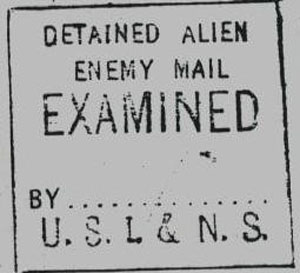 The Franke family experience provides ample evidence that once one came into its sights, the government had many techniques to rid itself of the danger the suspect presented. It was relentless.
The Franke family experience provides ample evidence that once one came into its sights, the government had many techniques to rid itself of the danger the suspect presented. It was relentless.
Living contentedly in their Baltimore, Maryland neighborhood, Otto Franke, his wife and 2 children did not know that the FBI was watching them closely. Mr. Franke, a US-born citizen of German parents, came under suspicion in 1940 when the FBI got an unsigned, semiliterate letter accusing Mr. Franke of coordinating “German underground work.”
His FBI dossier was opened and through diligent gumshoe work, the FBI got other unsubstantiated tips. Little was done to confirm any of the serious allegations and their work was so sloppy that it took more than a dozen tries for the FBI to get his address right.
In June 1941, with the apparent prodding of the FBI, Mr. Franke was asked to resign from his draftsman’s job. His supervisor’s recommendation letter stated that he was a “man of excellent character and integrity.” Confused about his citizenship status, the FBI finally realized that he wasn’t an alien and couldn’t be interned. It sent his case to another DOJ branch for his prosecution as a subversive. The Attorney General’s office demanded verification of what it deemed insufficient FBI evidence. In January 1942, an FBI search of Mr. Franke’s home yielded no incriminating evidence. The 1940 tips were reviewed, but could never be corroborated. There was no prosecution.
In February 1942, Roosevelt issued Executive Order 9066 authorizing the military to exclude citizens and aliens from militarily sensitive coastal areas. This order provided the legal basis for general exclusions from military zones, relocation and individual exclusions. A military review board was established in each military district giving the appearance of due process. Mr. Franke’s file was forwarded to the military. (Executive Order 9066)
On October 1942, having already lived for months in fear of the government’s next tactic, Mr. Franke appeared before his review board. Relying on spotty FBI information which now actually included some countervailing facts, the board still ordered him out of the Eastern Defense Command—the eastern seaboard. No government assistance facilitated the move. Fortunately for Mr. Franke, his company had a Lima, Ohio facility, so he and his family transferred there in March 1943.
By June 1943, as they were trying to resettle, the Army’s Continuous Security District Office ordered him fired as a subversive. After another aborted hiring and months of unemployment, Mr. Franke found a job in another Ohio town and the family moved again. In July 1944, that company moved to New York. Mr. Franke had to decline the position they offered in New York because of his exclusion order. Isolated, discouraged, stigmatized and in difficult financial straits, the Frankes continued trying to return to Baltimore.
In May 1945, the Army lifted its order. The family quickly returned to Maryland and attempted to resume a normal life after years of upheaval. Based on the article “Excluded” by Lewis H. Duiguid published in the Washington Post Magazine, January 3, 1999.
The Latin American Roundup
Hugo Droege emigrated from Germany to the Guatemalan highlands to find a better life. He married and lived quietly for 20 years far from Germany. He established and managed a coffee farm as he raised his family.
One night, six Guatemalan police arrived with guns drawn to take him away. Mr. Droege told his wife to save the farm. Forty-eight hours later, the Guatemalan government forced her to abandon it.
Pregnant with their third child, she, her two children and a mule, carrying the belongings they were allowed to take, left the farm to live with friends.
The Guatemalan police turned Mr. Droege over to American soldiers. He did not see his family again for five years. In December 1942, General George Marshall initiated the secret operation that led to Mr. Droege’s capture by sending a secret order to the US Caribbean Defense Command: “These interned nationals are to be used for exchange with interned American civilian nationals.” Pursuant to Marshall’s order, thousands like Mr. Droege from 12 Latin American countries were forcibly kidnapped and shipped to the US guarded by armed American soldiers.
After being told he was going on a boat, he was strip-searched six times. Soldiers held him and hundreds of others in darkness below the ship’s deck for what ended up being a month-long voyage to America. After six days in the dark, they were allowed to go on deck for a half an hour to see daylight. They were locked up like criminals and did not speak to each other. Open buckets were placed conveniently among the prisoners for bathroom use. The stench eventually stifled their hunger. Terror reigned. One man died. Many first saw the US in New Orleans.
Until their exchanges were scheduled, the Latin Americans were held in various US internment camps. Hugo Droege begged not to be sent back. He was told you have to go, tied up or on your own two feet. One month later, he was shipped to Germany at the height of the Allied bombing. During the five years he was away from Guatemala, survival was very difficult. Mr. Droege believes that the Latin American countries cooperated with the United States so that they could confiscate the property of those kidnapped. When he finally returned to Guatemala, the family had nothing left. The government had taken the farm.
Countries throughout Latin America profited the same way, seizing farms and businesses from those they turned over to the United States. The plight of German Latin Americans has yet to be acknowledged. Just after his 100th birthday, the patient Hugo Droege passed away, still waiting.
More Information on the Latin American Program
Repatriation
The Jacobs lived in Brooklyn, New York for years. Mr. and Mrs. Jacobs were German-born aliens. Their two boys were American. The family home was raided and ransacked on three separate occasions by the FBI. They never found any contraband (firearms, propaganda, or short-wave radio receivers).
Mr. Jacobs was arrested at his job in November 1944. Like many whose spouses were arrested, the family did not know where he was for some time. He was taken to Ellis Island. He was ordered interned even though his hearing board unanimously recommended release.
Mrs. Jacobs was ill and unable to maintain the household by herself. Not able to survive alone, she packed up her family’s belongings, left her home and arrived at Ellis Island with her two young sons asking for mercy. They were reluctantly admitted. Eventually, the family was sent to the Crystal City family internment camp where they lived until Mr. Jacobs finally agreed to be repatriated under threat of deportation.
They were transferred to Ellis Island, bordered the SS Aiken Victory in January 1946, months after the cessation of hostilities with the Axis nations, and returned to Germany. When the family arrived in the dead of winter, they were transported to Hohenasperg in a frigid, locked, heavily guarded boxcar. The bathroom was an open bucket in the corner.
Once there, Mrs. Jacobs, still ill, was sent to another facility. Mr. Jacobs and his sons were sent to a military prison and each placed in separate cells. The boys, 12 and 14, were treated like Nazis by the US Army guards. The younger son, Arthur, celebrated his 13th birthday alone in his cell. The guards marched the American boy to meals by the hanging tree, hands above his head, threatening him with death if he did not behave. His fellow inmates included high-ranking officers of the Third Reich who were being held for interrogation and denazification.
Eventually, the family was released, reunited and lived with Mr. Jacobs’ parents. Arthur was industrious and soon began working with the American GIs living in Germany. An officer’s wife worked on the boys’ behalf and arranged for them to live in America. Their parents never returned to the US and Arthur didn’t see them again for 11 years. Arthur became a major in the US Air Force. For the past 20 years, he has researched the government’s wartime treatment of German Americans, networked with other internees, authored a book on his internment experiences and sponsored an informational web site. He has devoted himself to public education on the events, laws and attitudes that destroyed his family life and that of thousands of others. His work continues.
© Karen E. Ebel March 2006

